This Napoleon Cake recipe features layers of thin, flaky pastry and creamy, luscious vanilla-flecked pastry cream. It’s a beautiful classic Russian cake that’s worthy of special occasions!
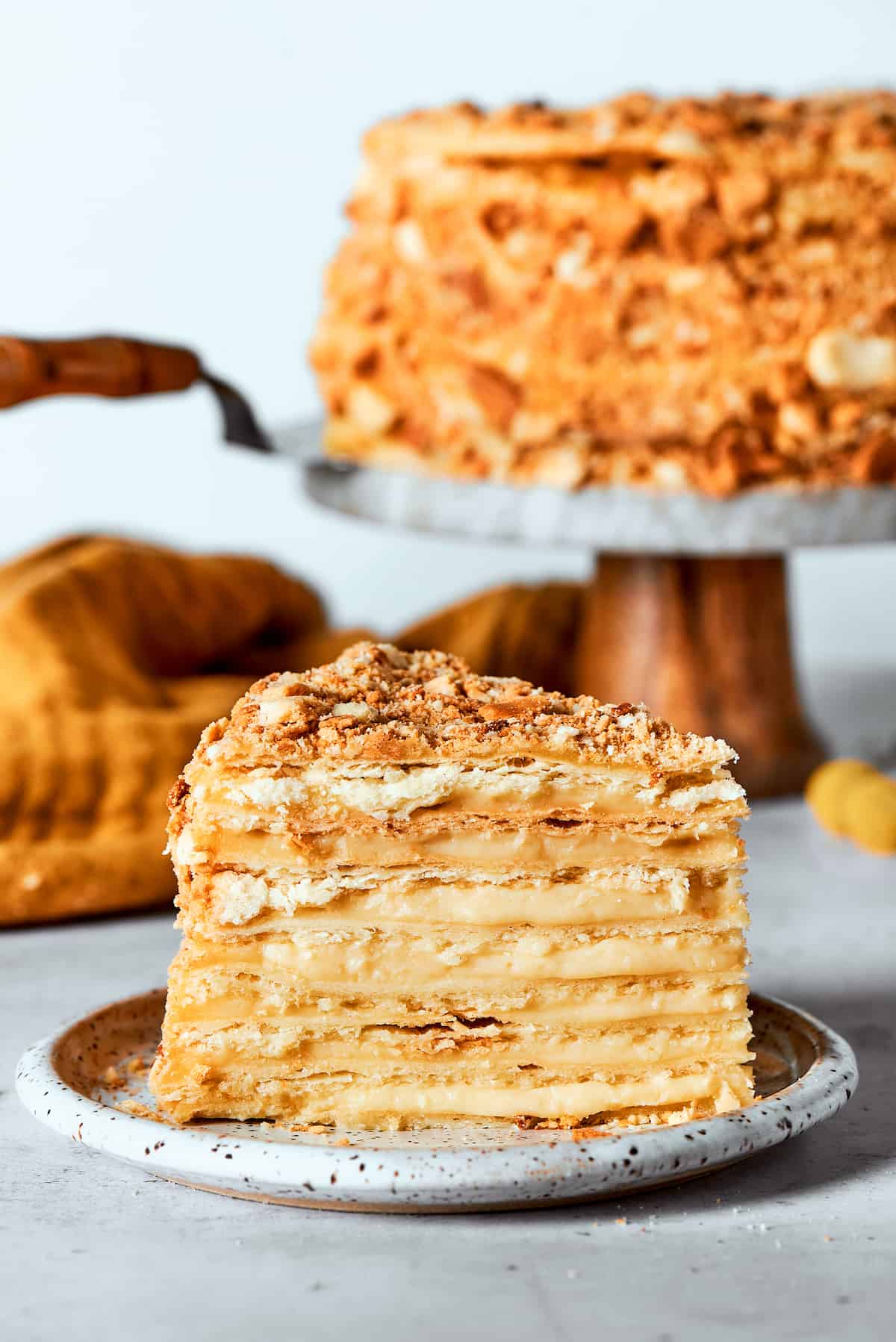
The Best Napoleon Cake
This Napoleon Cake is a show-stopper of a dessert, and it’s oh-so-decadent. The velvety smooth pastry cream is the real star, layered with delicate rounds of pastry that you can easily whip up yourself – or you can use pre-made puff pastry. Serve this elegant dessert with fresh berries or a sprinkle of chocolate shavings, or in thick slices all on its own. This cake is definitely worthy of a special occasion!
Why You’ll Love This Napoleon Cake Recipe
When you want to make a cake that’s a little different, turn to Napoleon cake! Here’s why you’ll love this Napoleon cake:
- Simple ingredients. The ingredients list includes nothing but common baking ingredients, yet they produce an incredible result.
- Pretty and decadent. I love the rich and creamy filling and the gorgeous layers of baked pastry. This cake is not only beautiful, but also decadently delicious!
- Special. You won’t find Napoleon cake on many bakery or restaurant menus. This sweet treat definitely stands out.
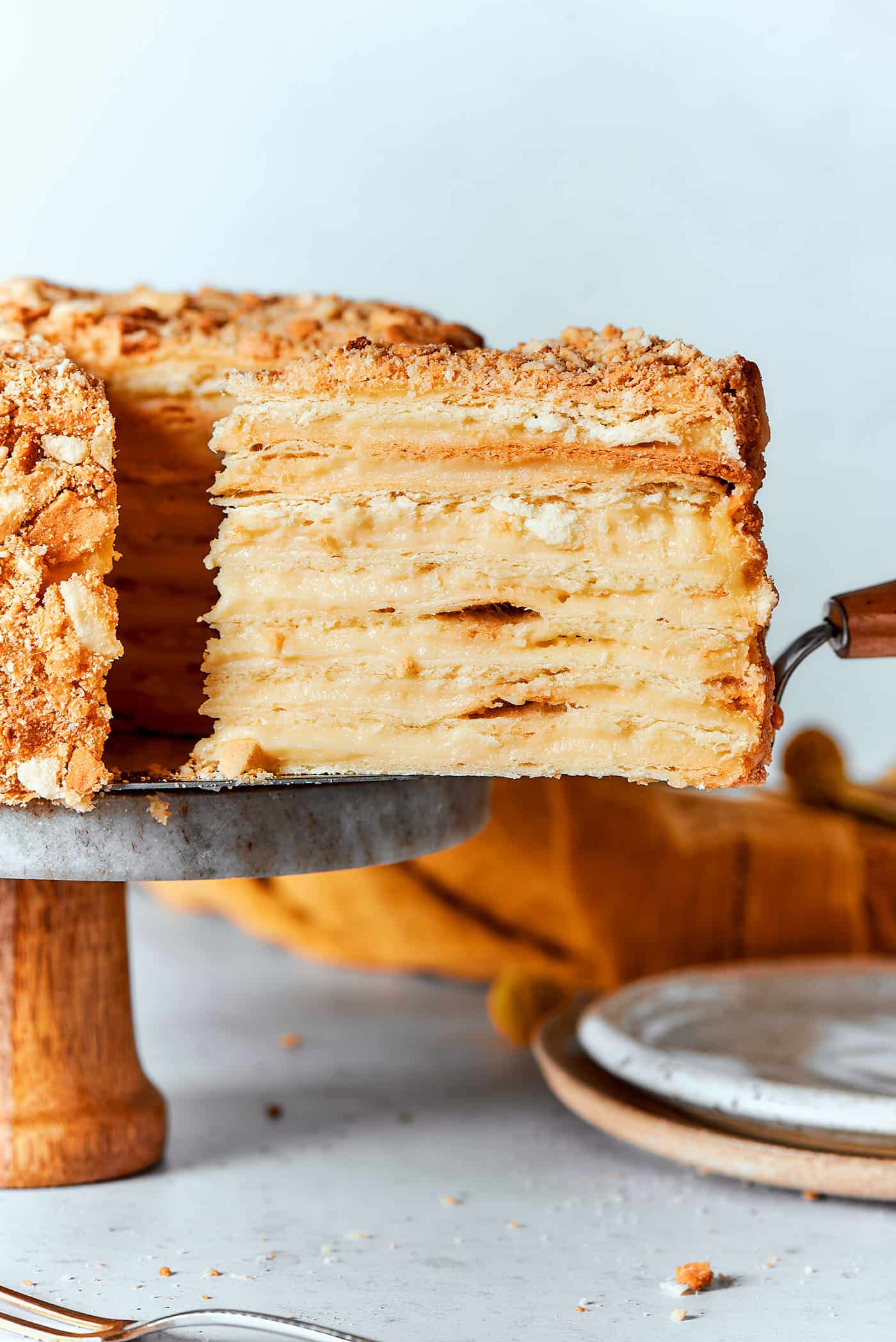
What Is Napoleon Cake?
A Napoleon cake is a cake of Russian origin that features thin stacks of flaky puff pastry layered with silky pastry cream, then covered with pastry crumbs. The cake is lightly flavored with vanilla. As the cake chills overnight, the pastry layers soak up the creamy filling, making the pastry soft and tender. The cake practically melts in your mouth when you eat it.
A Napoleon cake traditionally has at least 8 pastry layers, and sometimes more! It is not the same as Napoleon dessert, which has less and thicker pastry layers along with the pastry cream. This cake is more like a crepe cake or a French mille-feuille cake with a chilling technique similar to an American ice box cake, but with a style all its own.
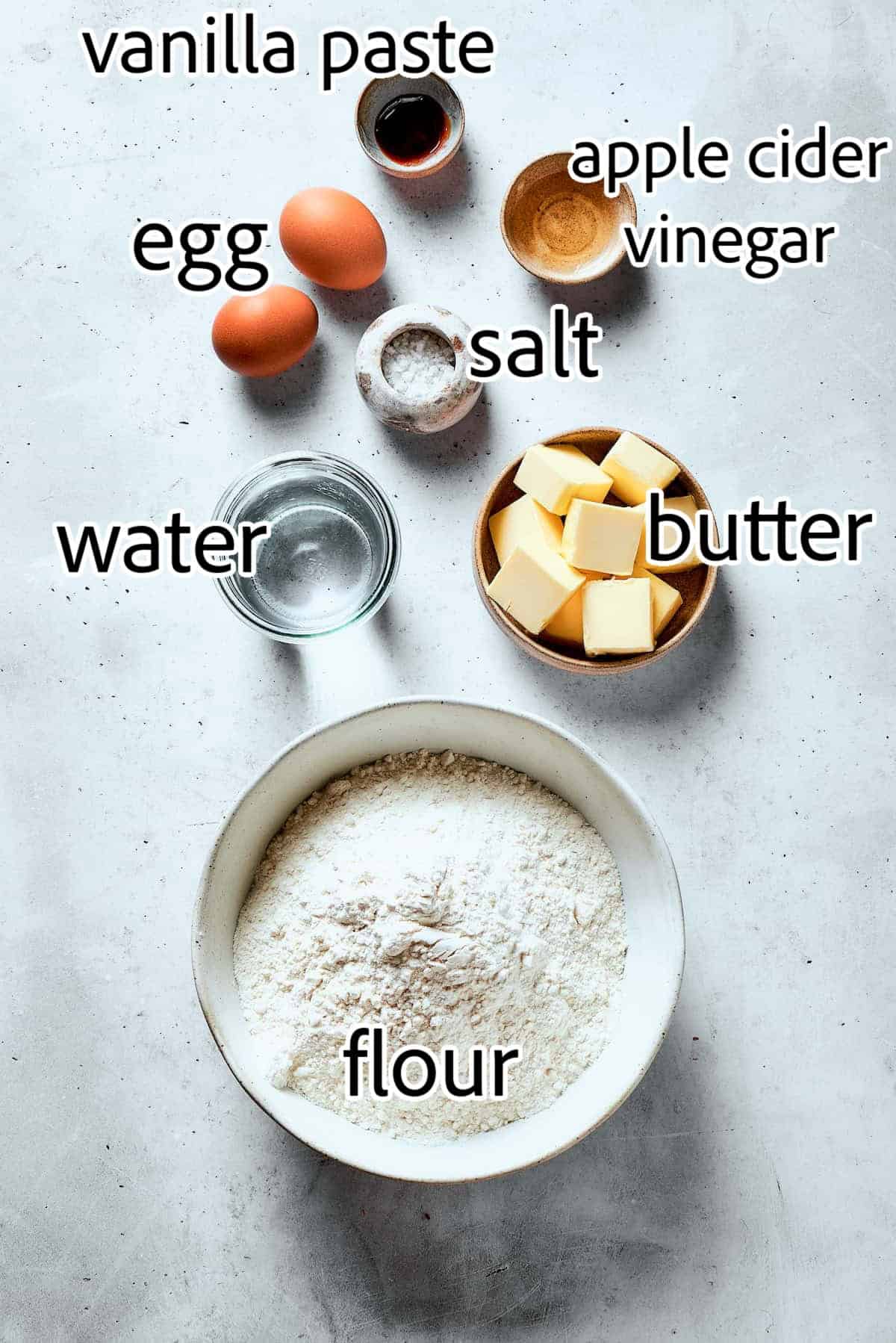
Recipe Ingredients
Here’s an overview of what you’ll need to make this Napoleon cake recipe.
Scroll down to the printable recipe card at the end of this post for the exact ingredient amounts.
For the Pastry Circles
- All-purpose flour
- Salt
- Butter – I use unsalted butter, so I can control the amount of salt in the pastry dough.
- Eggs
- Ice water
- Apple cider vinegar – You can use white vinegar if you don’t have apple cider vinegar.
- Vanilla paste – This adds a light vanilla flavoring to the pastry dough, so lovely.
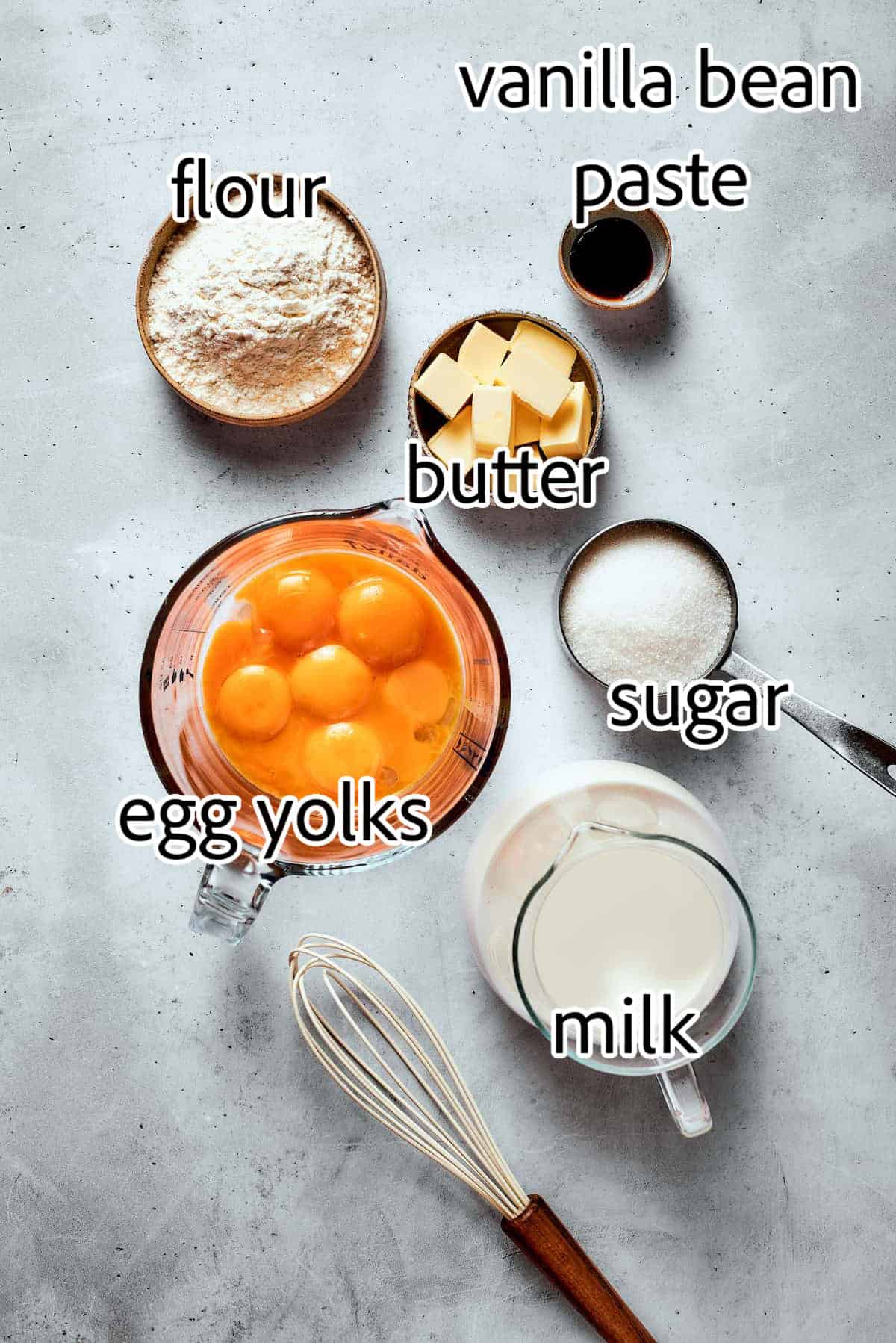
Egg Yolk Cream
- Egg yolks – This gives the filling its creamy, rich texture, plus adds flavor. Save your egg whites and make an angel food cake!
- Granulated sugar
- All-purpose flour
- Milk – I use whole milk for richness.
- Butter – I use unsalted butter, to keep the pastry cream flavor very delicate.
- Vanilla bean paste – This adds beautiful flavor to the pastry cream.
How to Make Napoleon Cake
Even though this cake does take time to make, none of the steps are difficult. Follow along with the photos below to help you make this Napoleon Cake recipe:
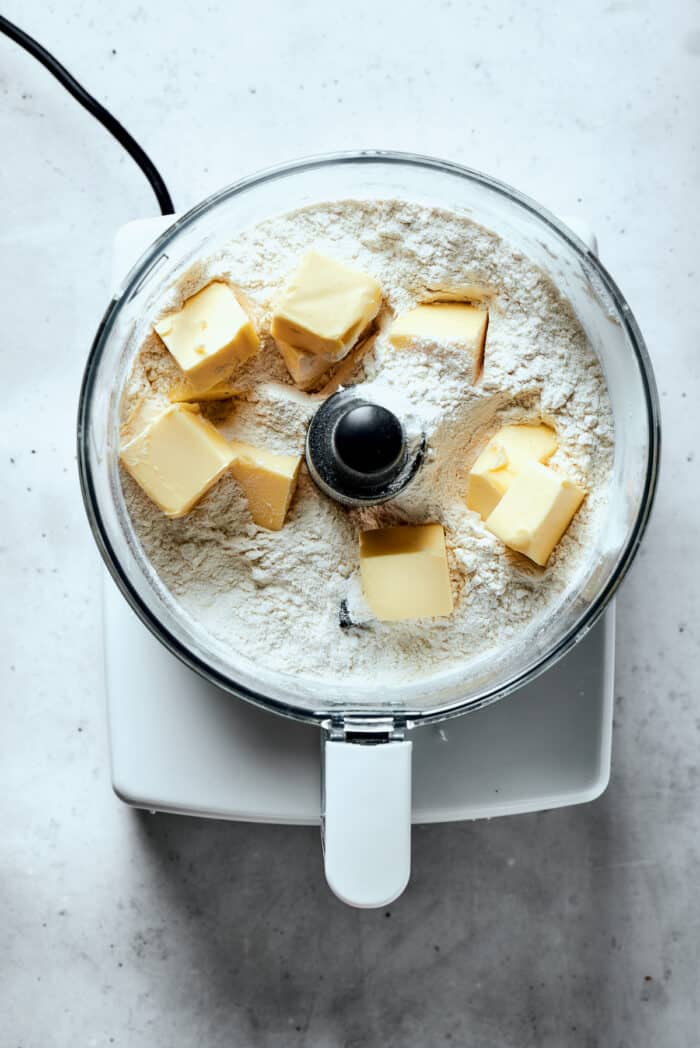
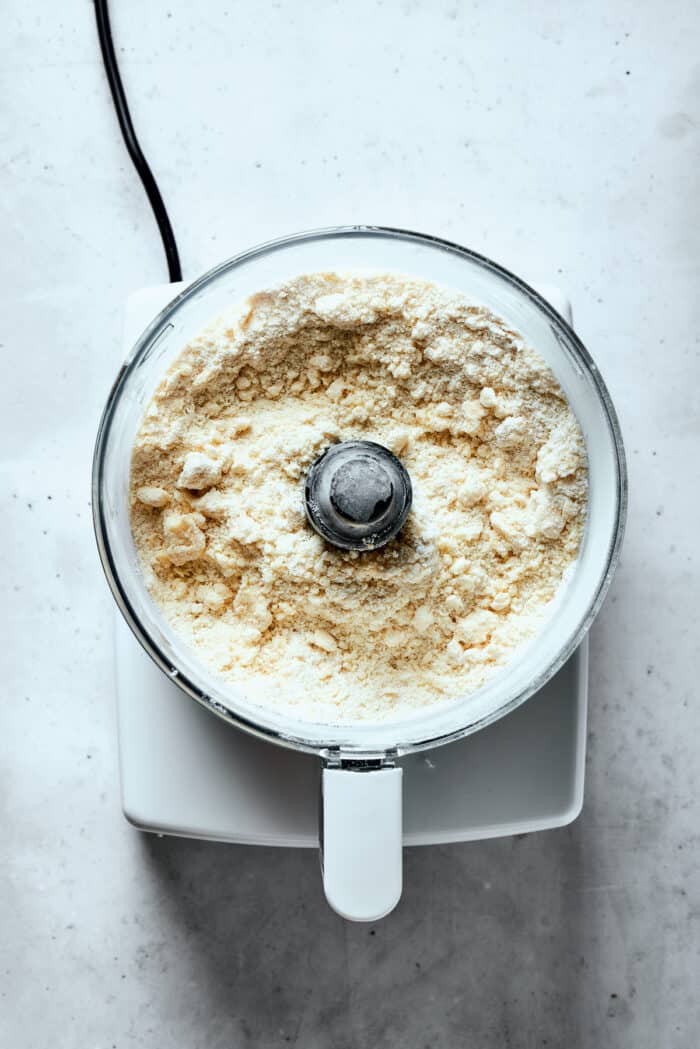
- Combine the flour, salt, and butter. Place the flour, salt, and butter in the bowl of a food processor and pulse until crumbs are formed.
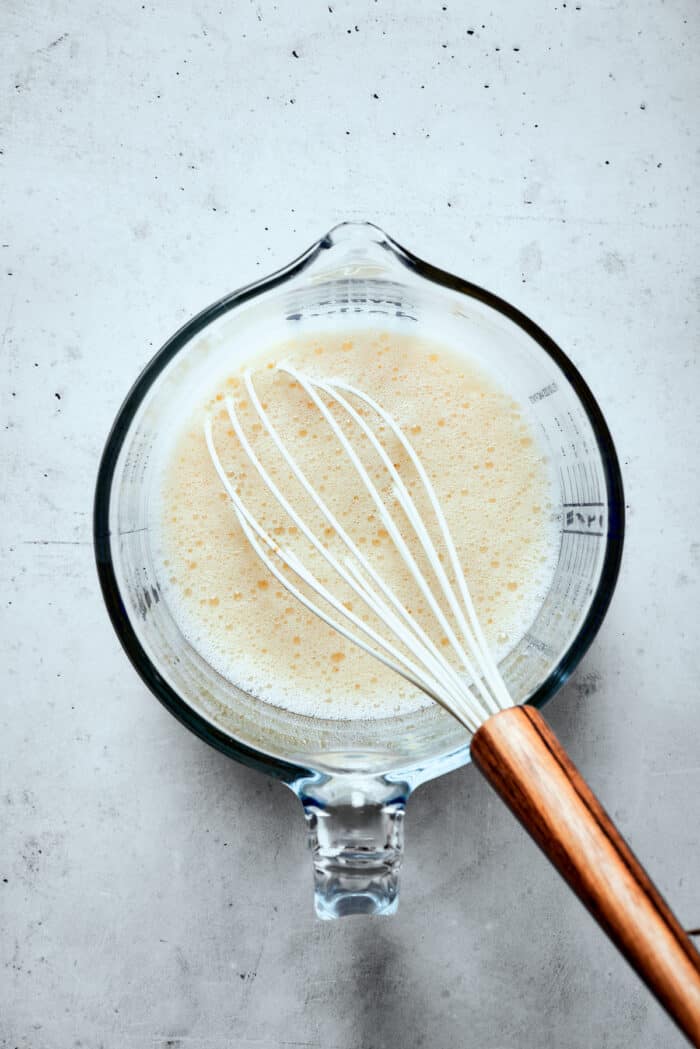
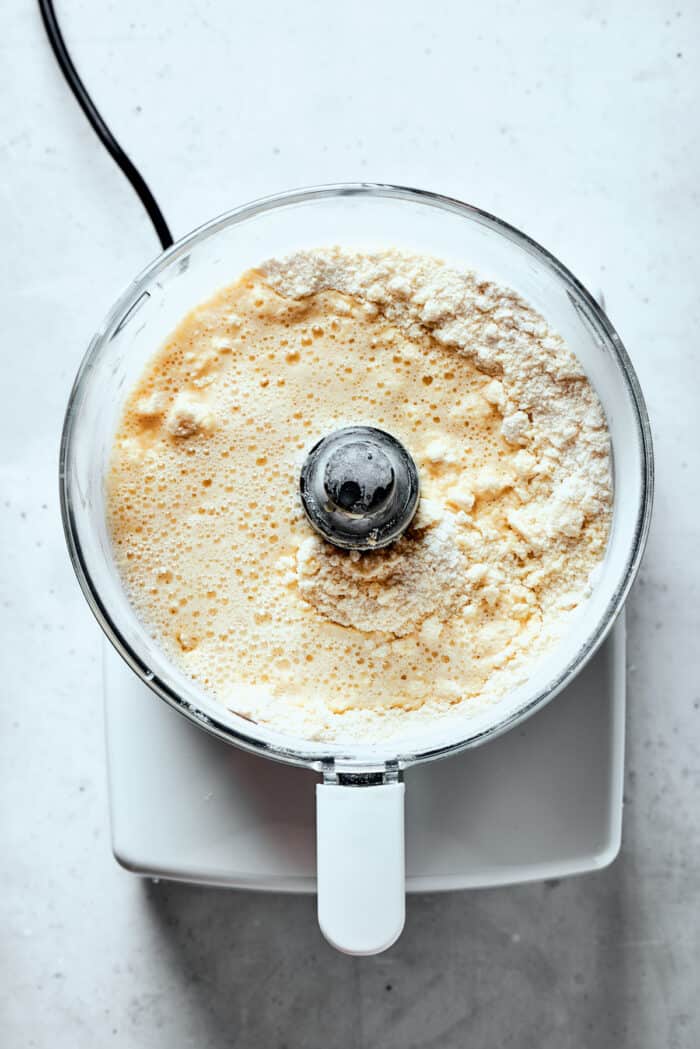
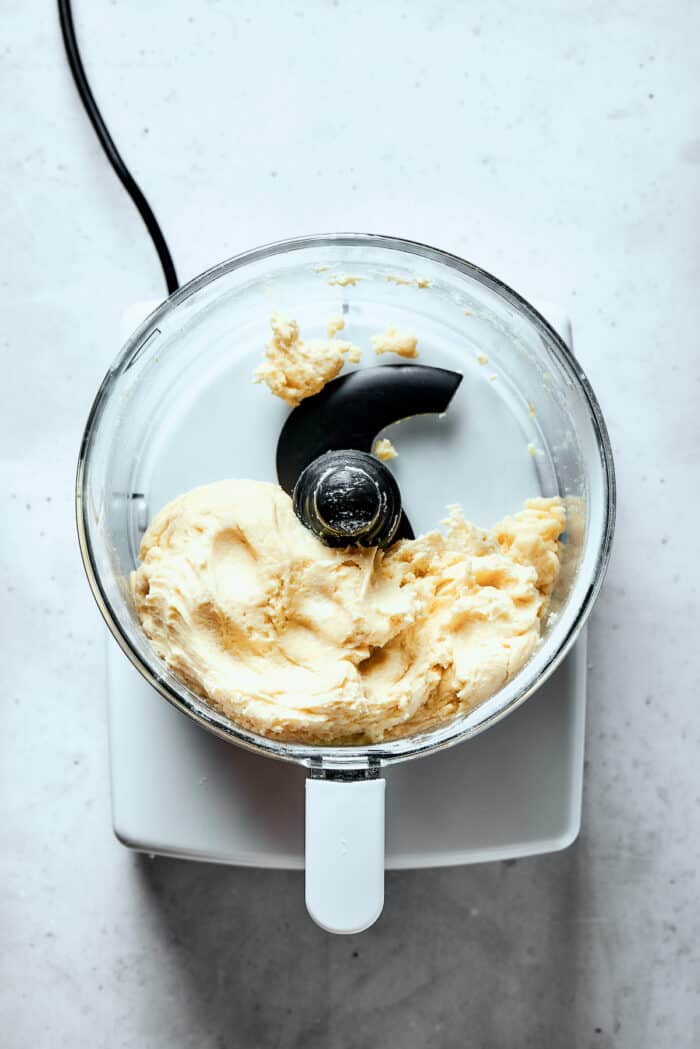
- Combine the wet ingredients. In a separate bowl, whisk together the eggs, ice water, apple cider vinegar, and vanilla paste.
- Add the egg mixture to form the dough. Gradually add the egg mixture to the flour-butter crumbs and continue pulsing in the food processor until the crumbs start sticking and forming a dough. Don’t overmix; you want the dough to be just combined.
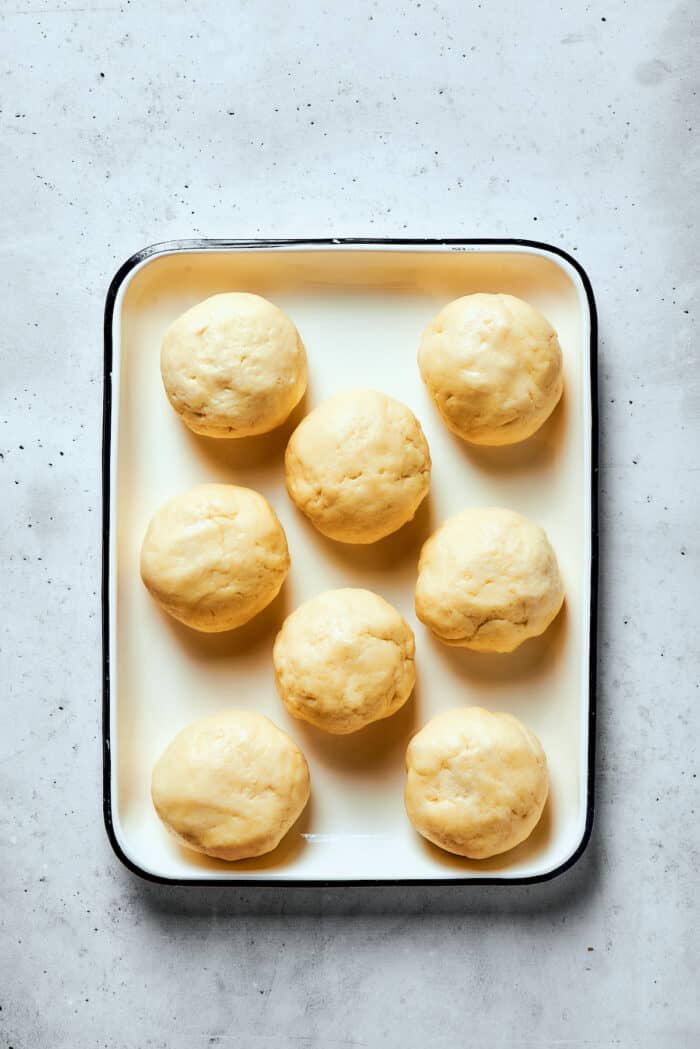
- Divide the dough and chill. Divide the dough into 8 equal portions. Roll each piece into a ball, flatten it into a disk, wrap it tightly with plastic wrap, and refrigerate for 2-3 hours.
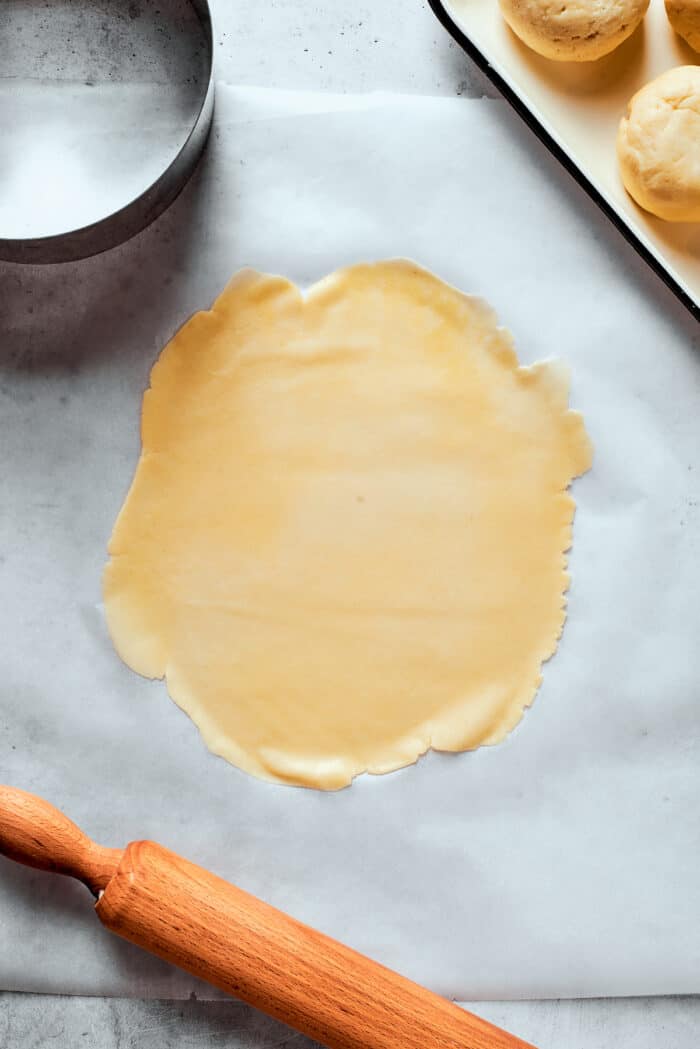
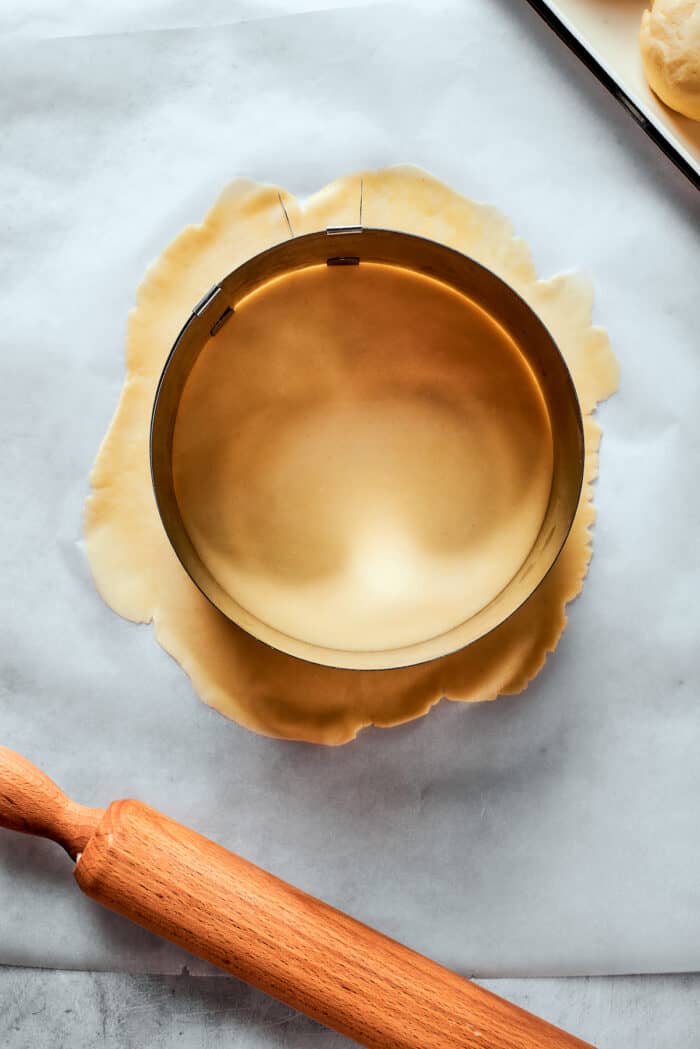
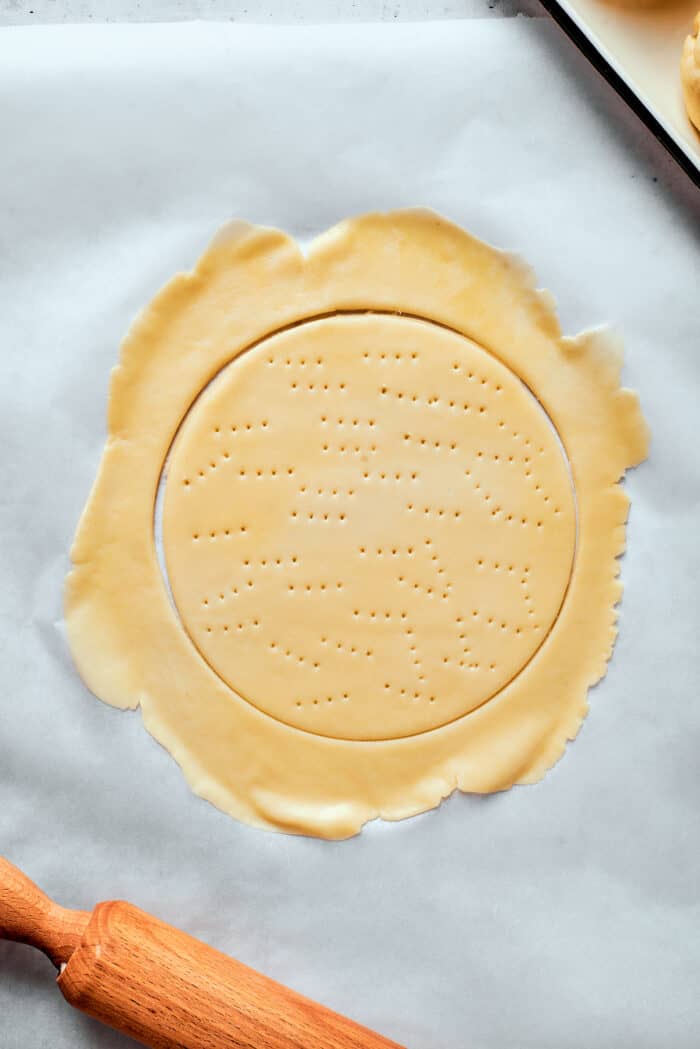
- Roll out the dough. Roll out each portion of chilled dough into a thin circle on parchment paper. Use a round 8″ mold to mark the crust circle, ensuring uniformity for each pastry circle. If you don’t have a mold, use a plate or pan that’s about 8″ in diameter and cut the dough with a knife, following around the perimeter. Repeat this step eight times to create eight pastry circles, leaving the dough outside the pastry circles just where it is.
- Prick the dough. Prick the dough all over with a fork to prevent it from puffing up too much during baking.
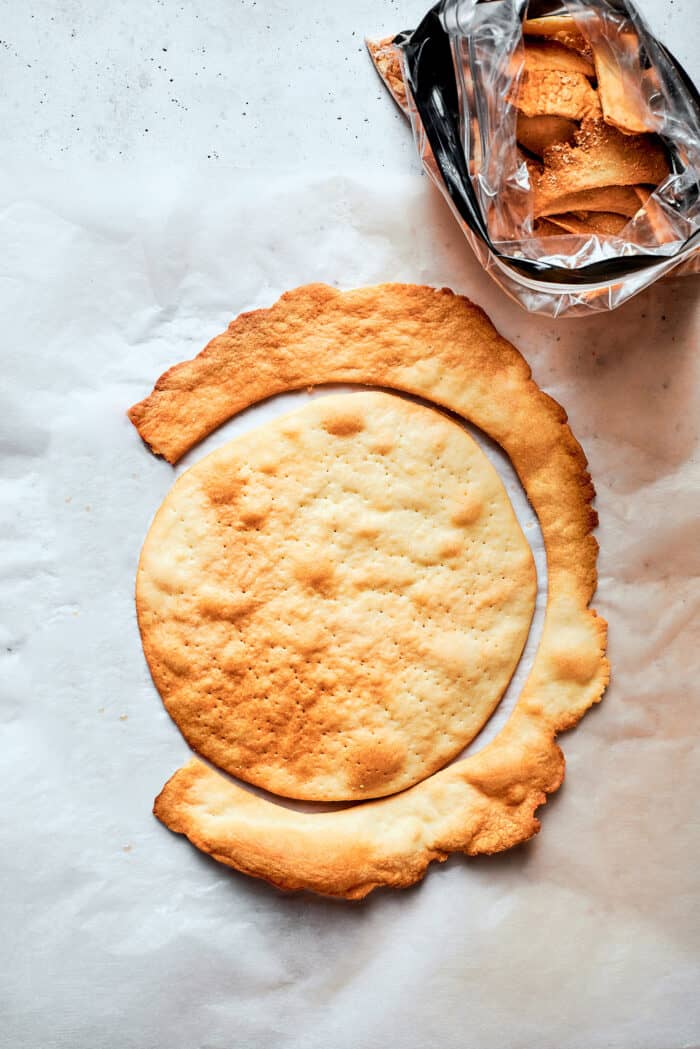
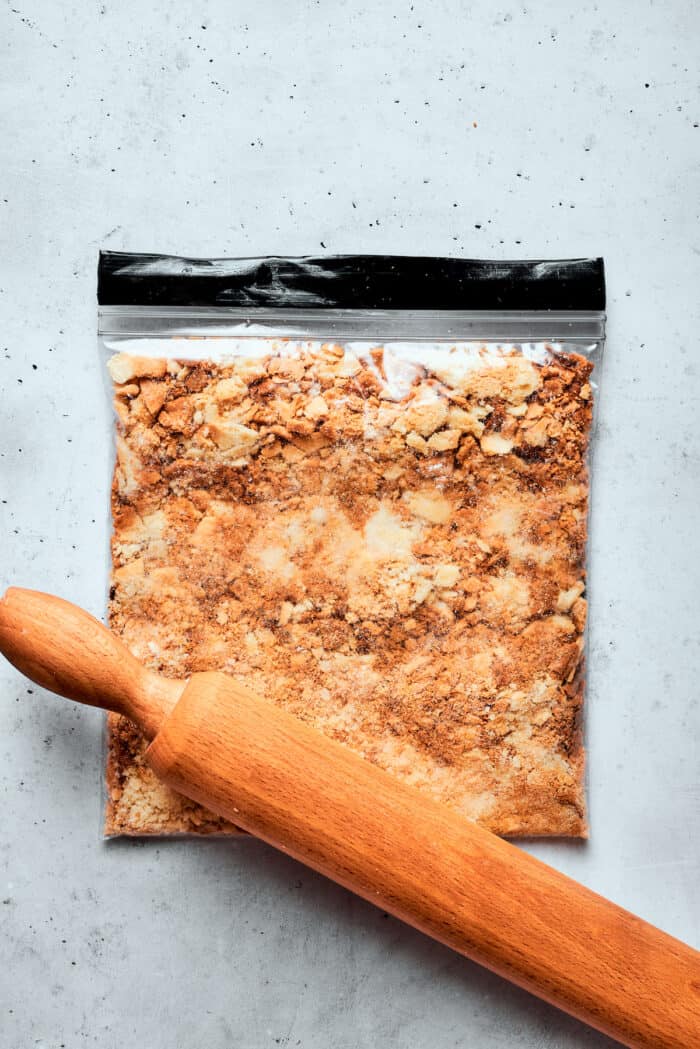
- Bake. Bake each pastry circle for about 10-12 minutes or until golden brown. Keep a close eye on them, as they can burn quickly. Let the baked layers cool completely.
- Make the pastry crumbs. Remove the outer pastry rings, place them in a ziplock bag, and crush them into crumbs with a rolling pin. Set aside. This will be used to cover the outside of the cake.
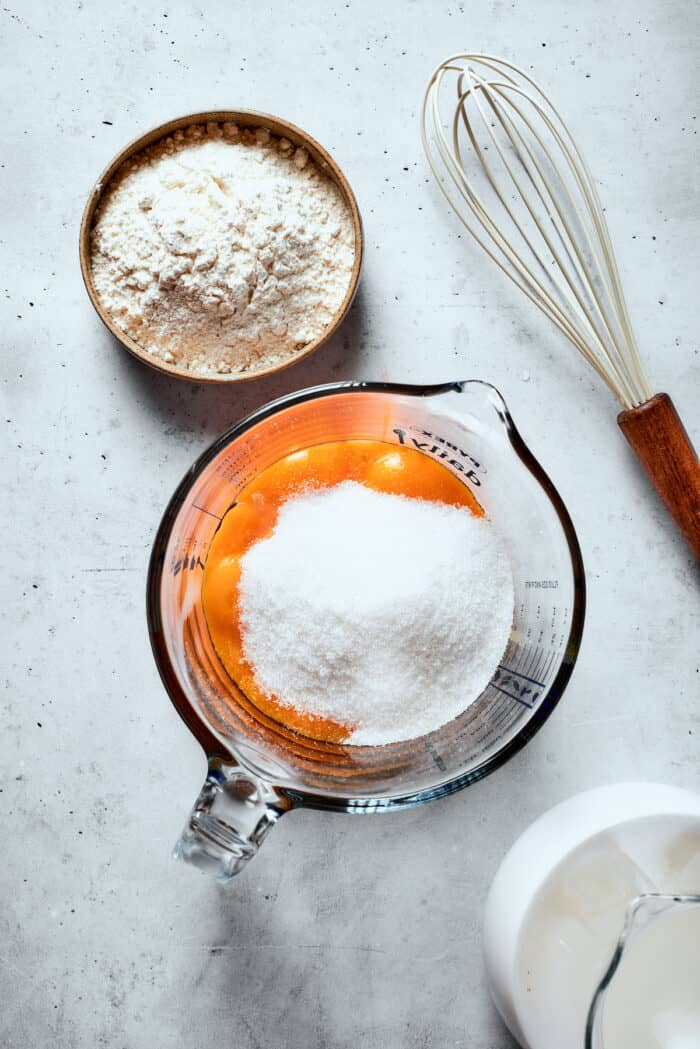
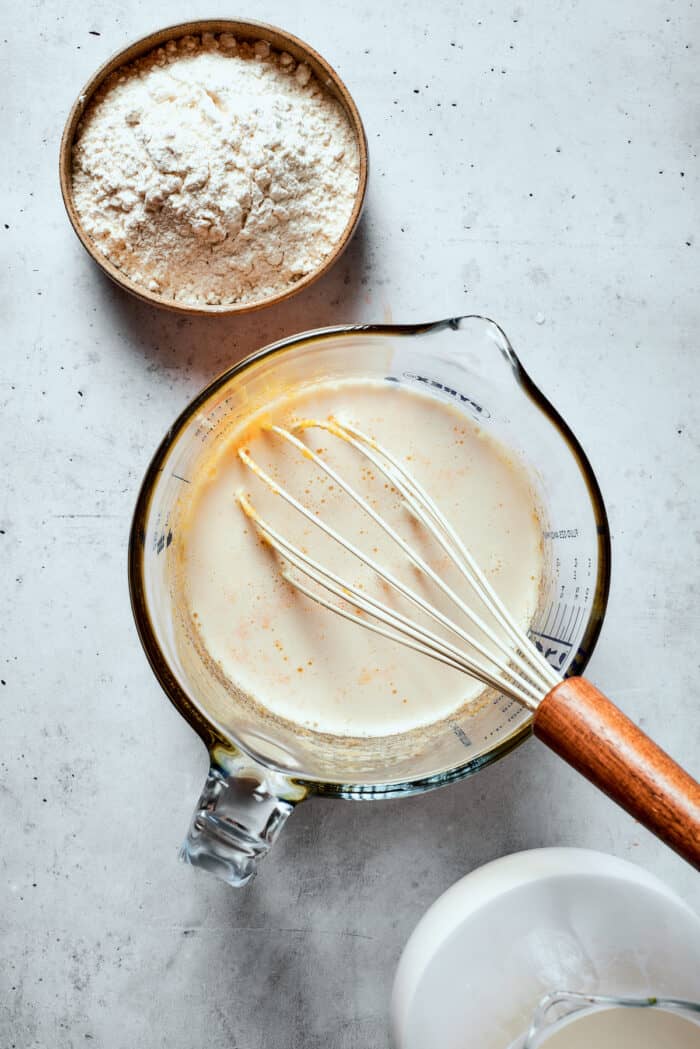
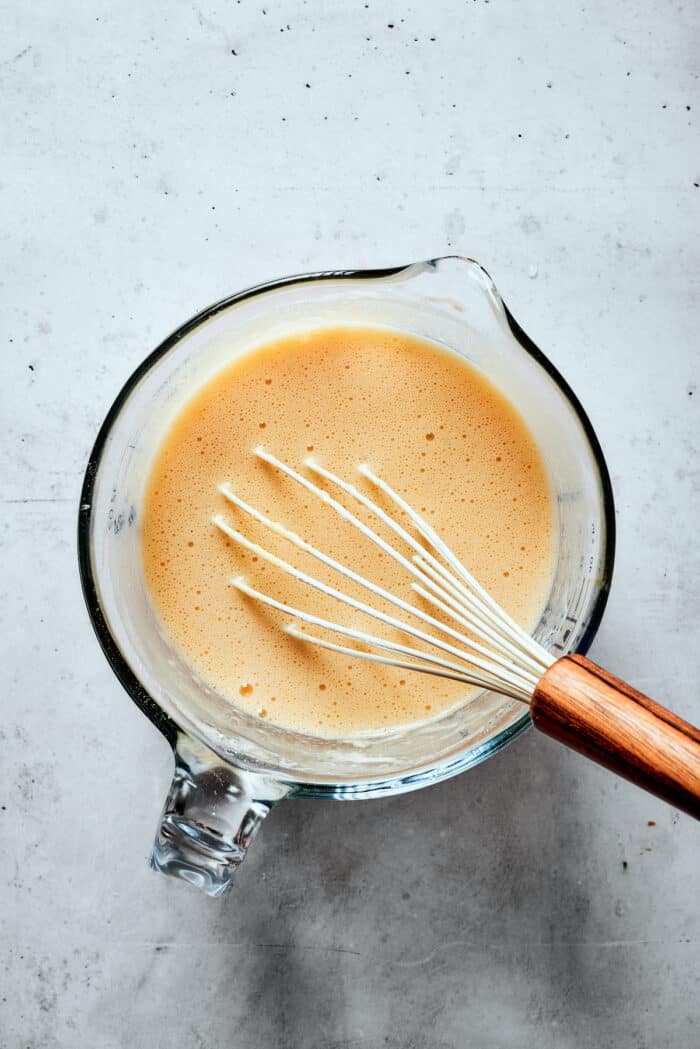
- Now, make the egg cream. In a medium bowl whisk together egg yolks and sugar, adding a little bit of milk as needed to help with mixing.
- Whisk in the flour. Next, whisk the flour into the egg mixture until you have a uniform, lump-free batter. Add a little milk if the batter is too thick.
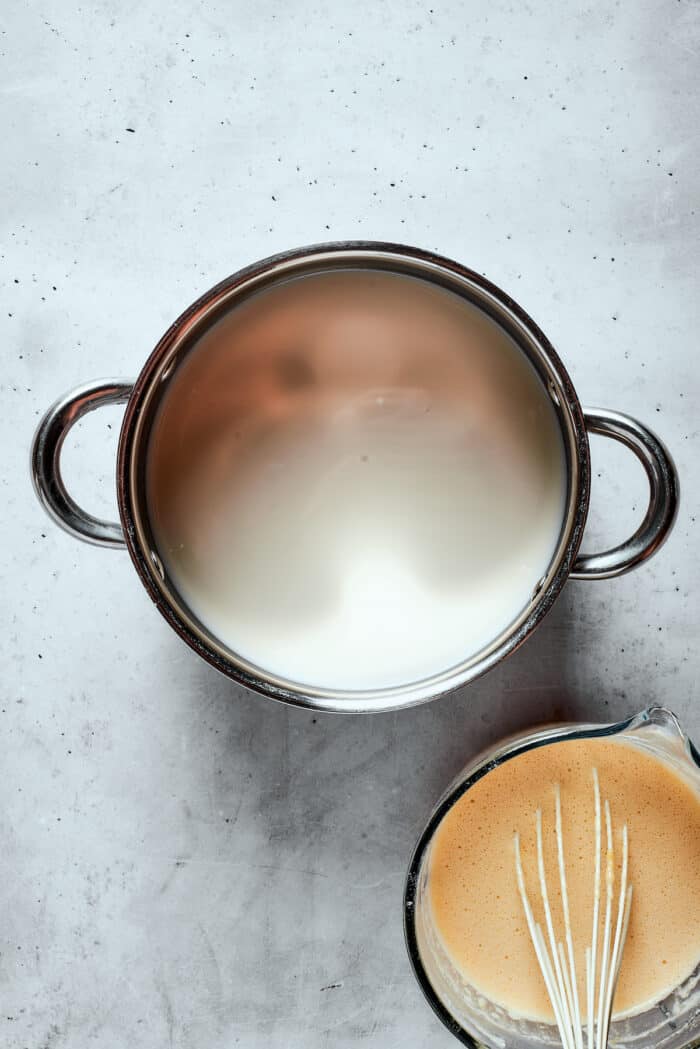
- Heat the remaining milk and temper the eggs. Heat the remaining milk in a separate saucepan until just boiling. Very slowly pour the hot milk into the egg yolk mixture to temper the eggs, stirring the whole time.
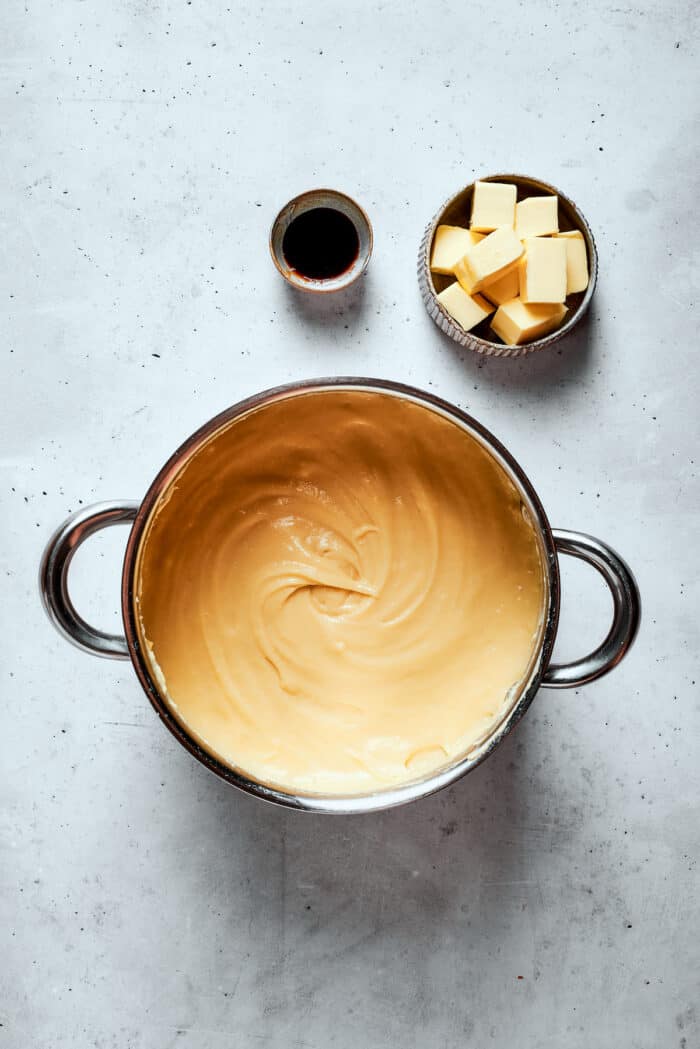
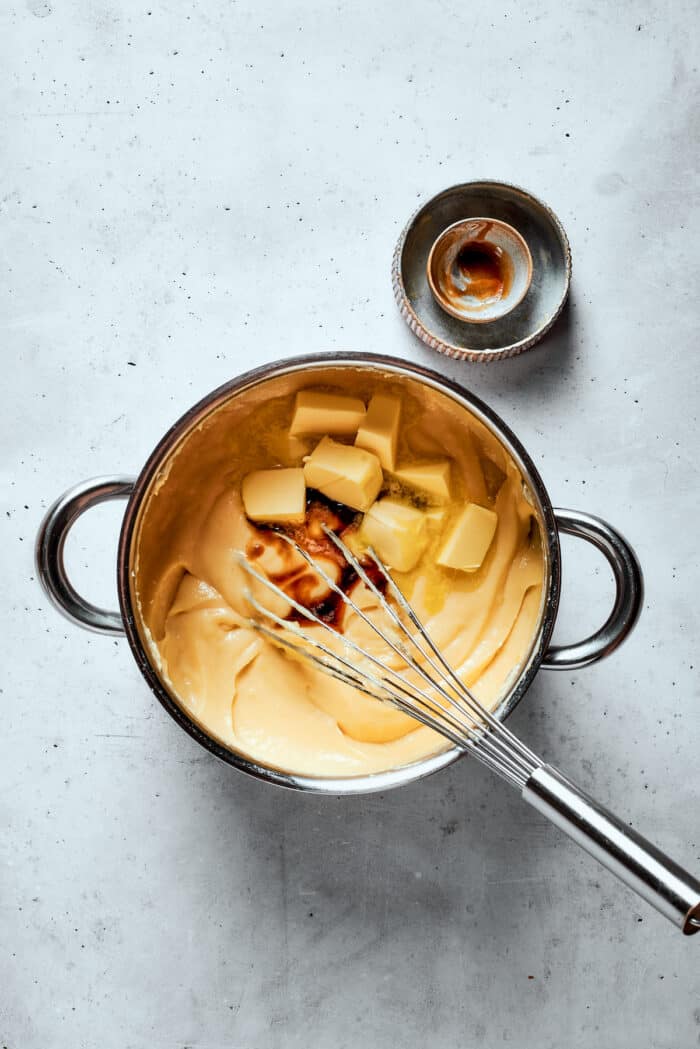
- Cook to thicken. Return the milk and egg yolk mixture to the saucepan and stir constantly, until the mixture thickens and just comes to a boil.
- Add the butter and vanilla paste. Remove the egg yolk cream from the heat and stir in the butter and vanilla paste, until the butter is completely melted and the mixture is smooth.
- Cool the cream. Transfer the egg yolk cream to a bowl and press plastic wrap directly onto the surface of the cream to prevent a skin from forming. Let cool completely.
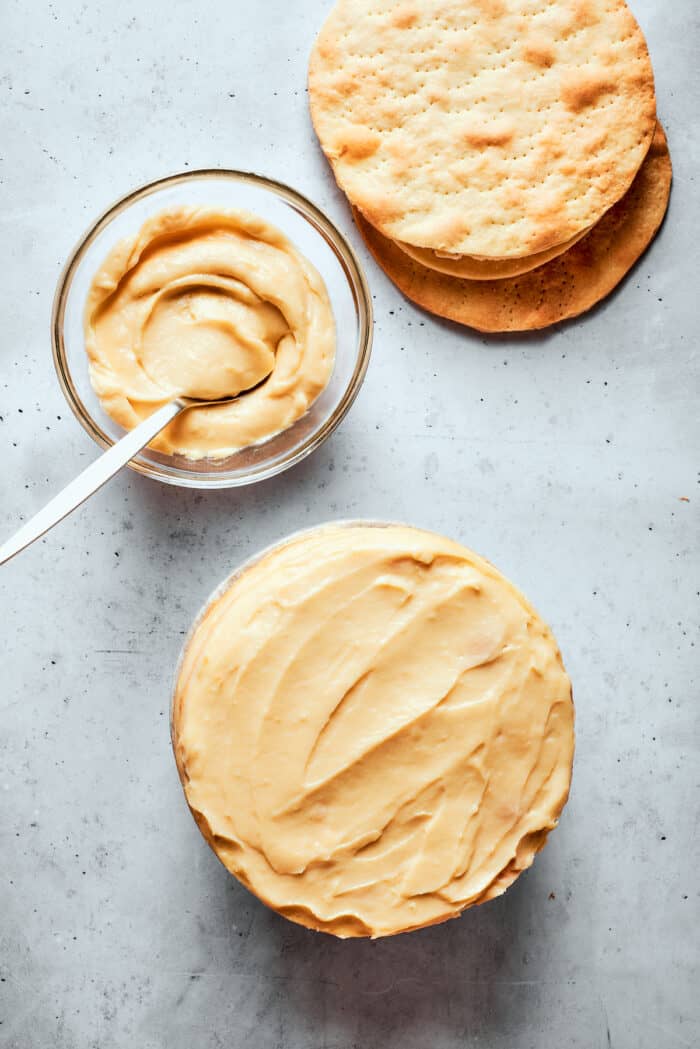
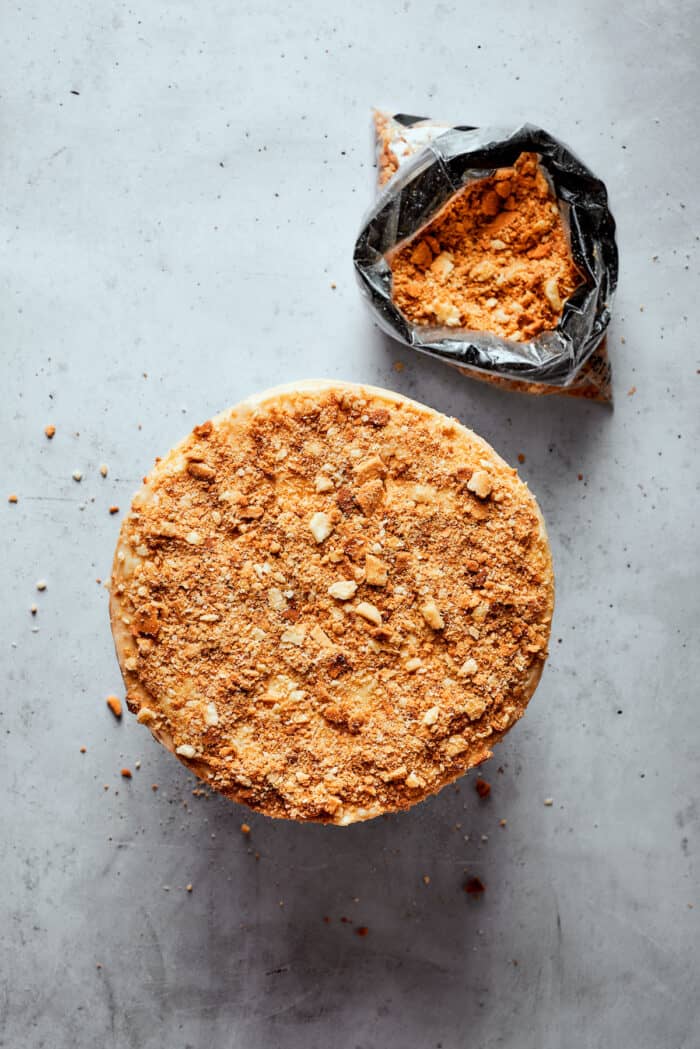
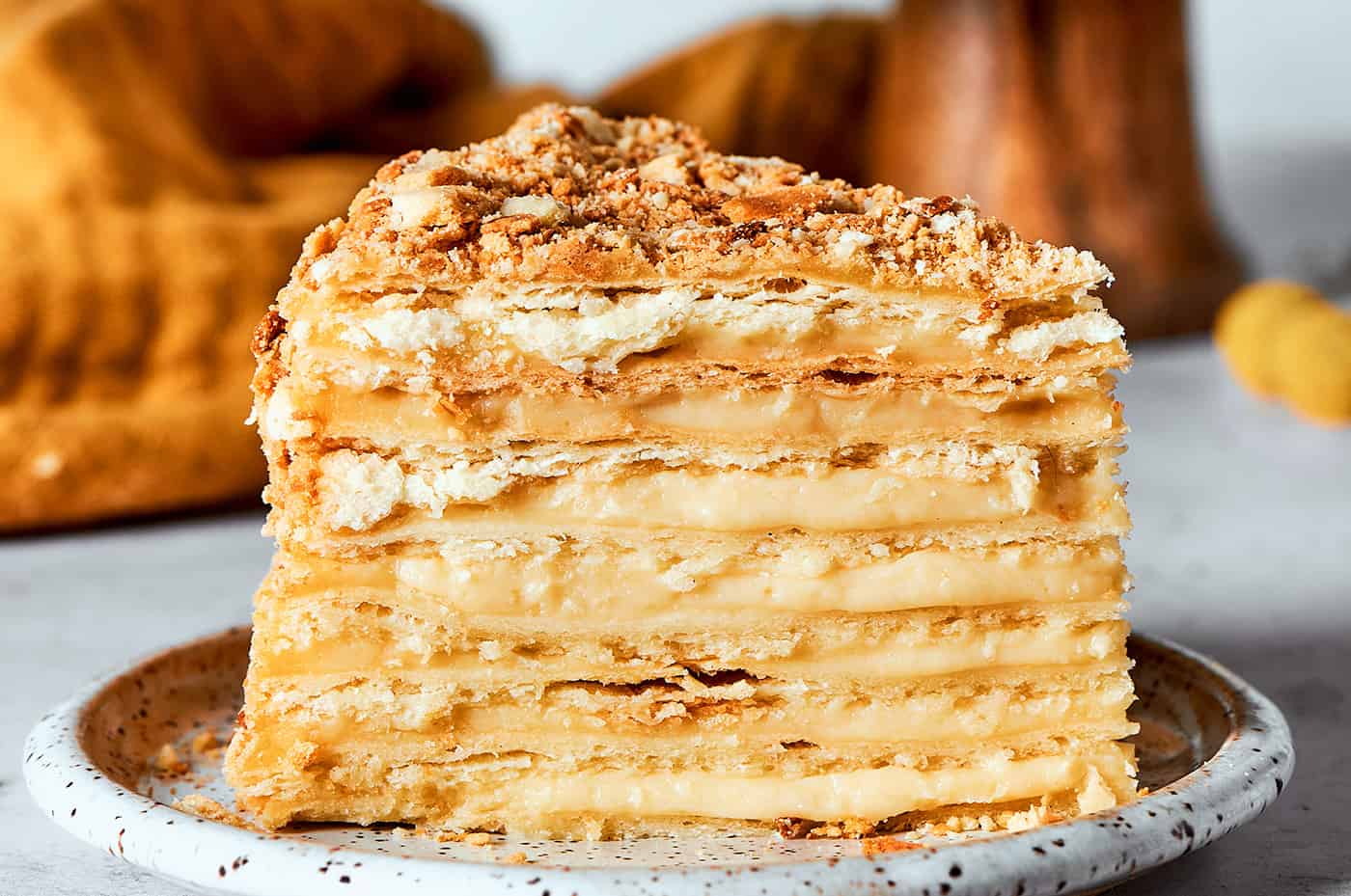
- Assemble the cake layers. Once the pastry circles and cream are completely cooled, begin layering. Place one layer of baked pastry on a serving platter. Then spread 2-3 tablespoons of the egg yolk cream evenly over the top. Alternate between pastry circles and cream layers until all the pastry circles are used.
- Finish the cake. Spread an even layer of egg yolk cream over the top and onto the sides of the cake. Then gently press the crushed pastry crumbs onto the cream, all over the cake.
- Chill. Refrigerate the Napoleon cake for at least 3 hours, or overnight is recommended. This allows the layers to meld together, for the egg yolk cream to soak into the pastry layers and soften them.
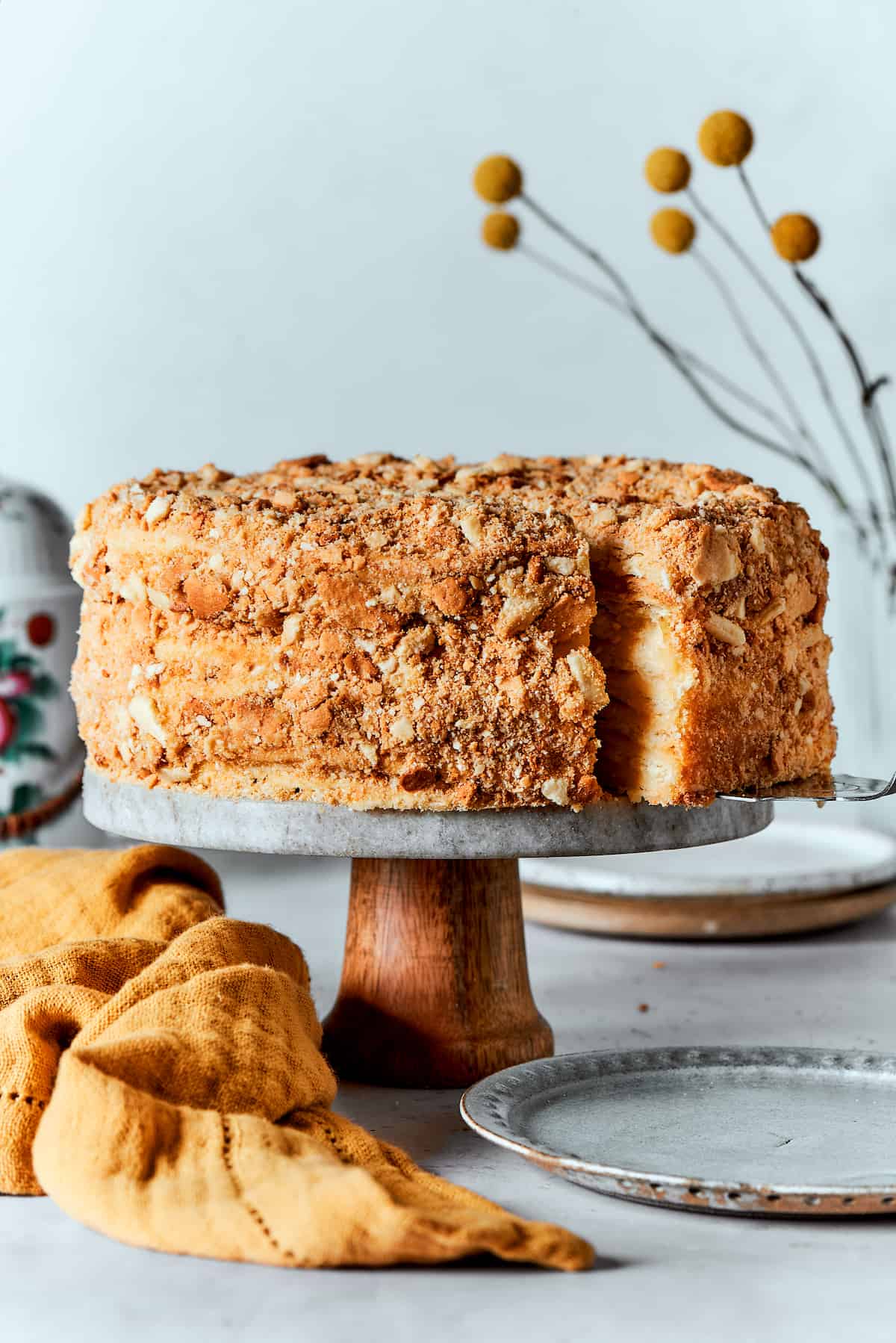
Tips for Success + a Variation
Here are a few tips that can help you make a perfect Napoleon cake, plus a way to make this cake easier and quicker:
- Don’t overbake the pastry circles. Keep a close eye on the pastry circles as they are baking, so they don’t overbake. Pull them from the oven when they are golden brown.
- Briefly rest the pastry dough on the counter before rolling. To help you roll the pastry dough out easily, let it sit on the counter for about 5 minutes. You don’t want it to warm up too much, but a short rest at room temperature will make it easier to roll thinly.
- Refrigerate the cake overnight. One of the beauties of this cake is that the longer it sits the more the pastry circles absorb the rich egg yolk cream. If you can, make the cake up to 24 hours in advance of when you plan to serve it.
- Variation: use puff pastry. If you’re not up for making the pastry circles, or maybe you’re just short on time, you can use store-bought puff pastry instead – look for it in the freezer section. Follow the defrosting instructions on the package. Then use a rolling pin to roll out the puff pastry to make it thinner.
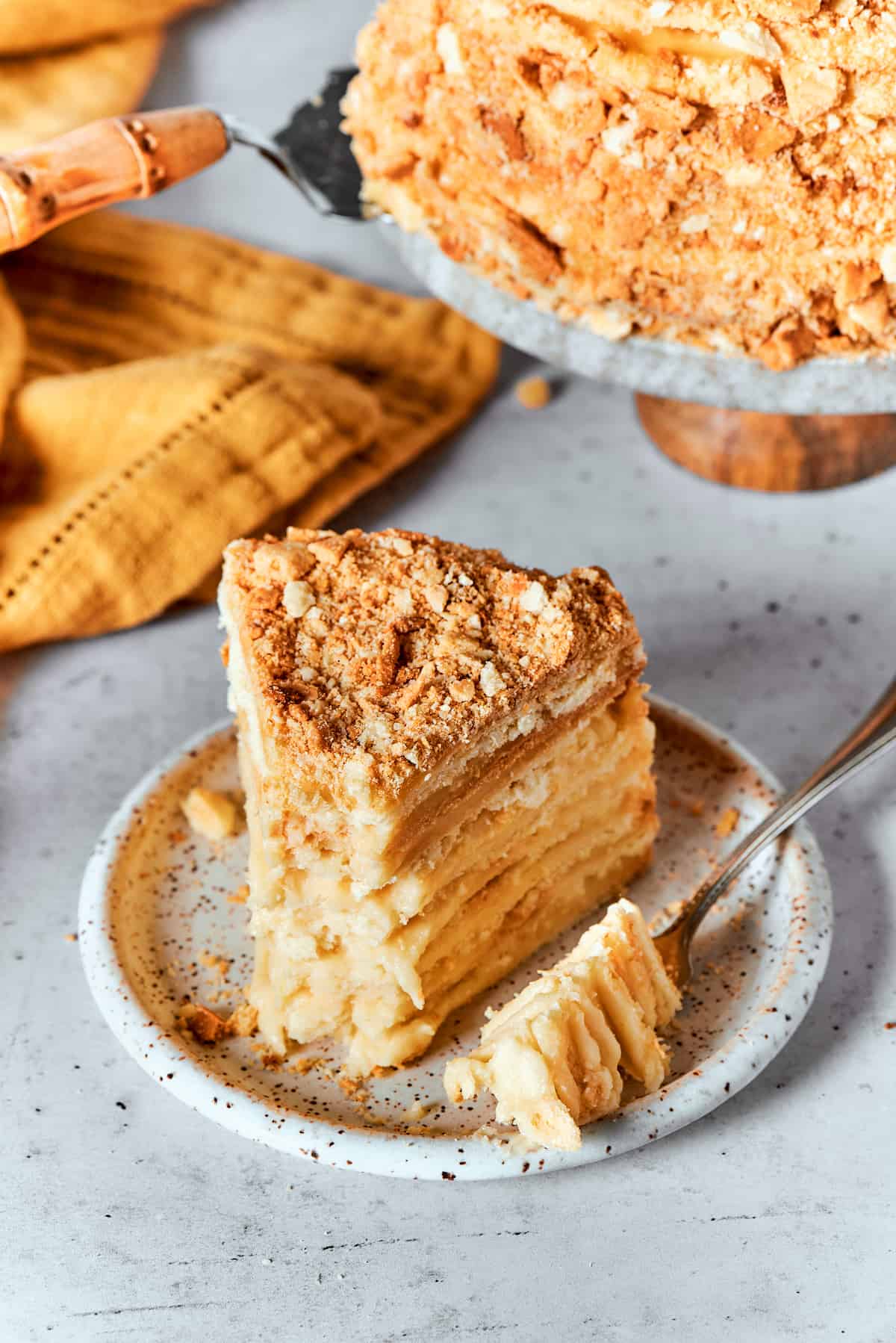
Serving Suggestions
Napoleon cake is a delicately sweet and very special dessert. It’s beautiful with a cup of coffee or tea, or try some of these serving suggestions:
- Fresh fruit. Fresh fruit is the perfect accompaniment to slices of Napoleon cake. I especially like berries – strawberries, blueberries, raspberries, and blackberries. Sweet, juicy peach slices are also very good.
- Or add a fruit sauce. Homemade strawberry sauce or raspberry sauce also add bright berry flavor.
- Add chocolate. For a little chocolate, drizzle hot fudge sauce over individual pieces of cake. Or just sprinkle with chocolate shavings.
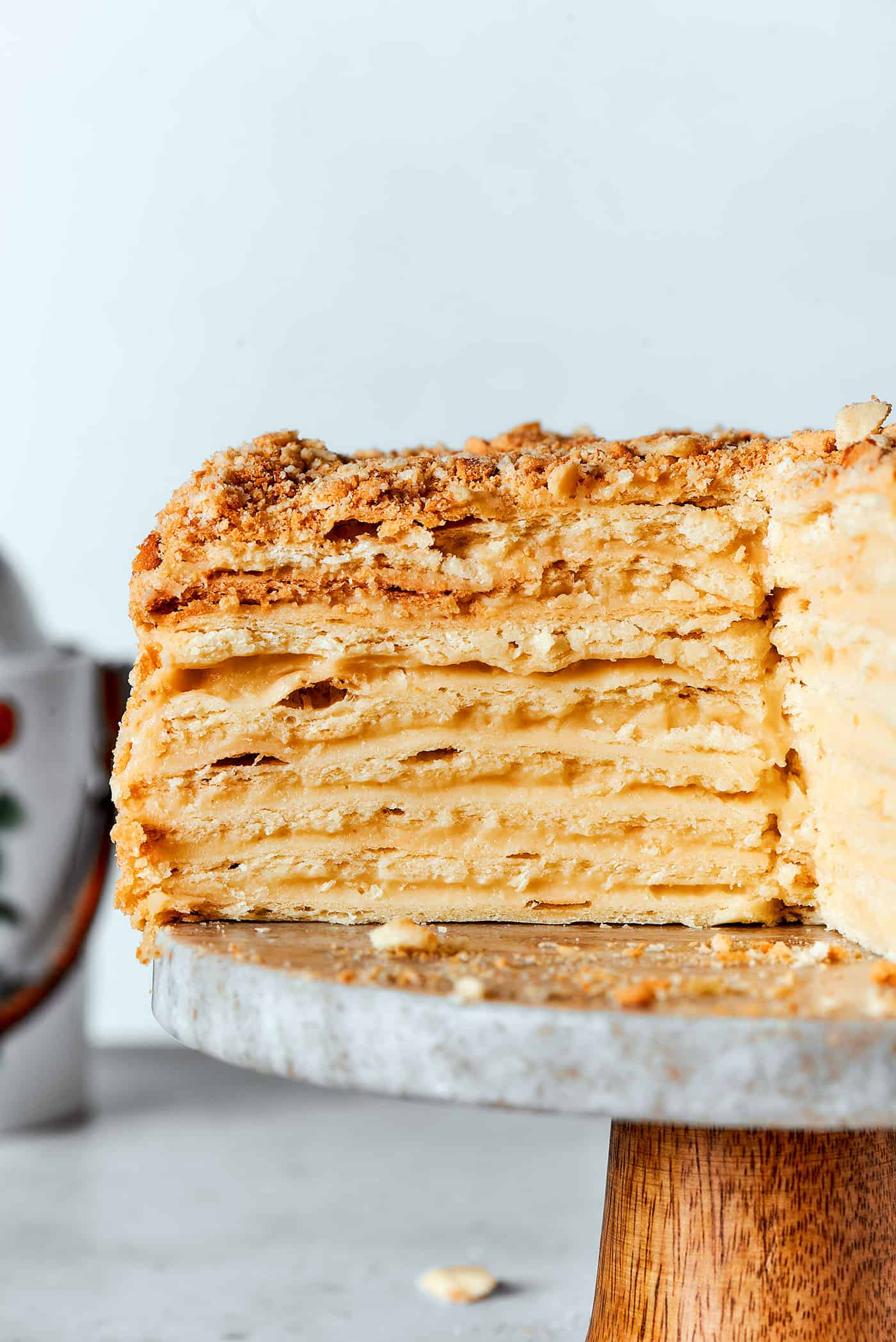
How to Store Leftovers
If you have any leftover cake, place it in an airtight container or cover it with foil or plastic wrap. Store it in the fridge for up to 5 days. Serve the cake cold, after letting it sit on the counter for 10 minutes. I do not recommend freezing this cake.
More Cake Recipes To Try
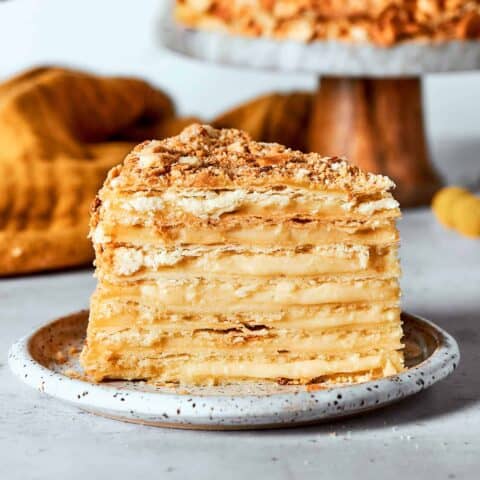
Napoleon Cake
Ingredients
For the pastry circles
- 5½ cups all-purpose flour
- Pinch of salt
- 3½ sticks unsalted butter cold and cubed
- 2 large eggs
- ¾ cup ice water
- 1½ tablespoons apple cider vinegar
- 1 teaspoon vanilla paste
For the egg yolk cream
- 6 large egg yolks
- 1 cup granulated sugar
- ⅔ cup all-purpose flour
- 4 cups whole milk divided
- 1 cup unsalted butter
- 2 teaspoons vanilla paste
Instructions
- For the pastry circles: Place the flour, salt, and butter in the bowl of a food processor and pulse until crumbs form.
- In a separate bowl, whisk together the eggs, ice water, apple cider vinegar, and vanilla paste.
- Gradually add the egg mixture to the flour-butter crumbs in the food processor and continue pulsing until the crumbs start sticking together and forming a dough. Be careful not to overmix; you want the dough to be just combined.
- Divide the dough into 8 equal portions. Roll each piece into a ball, then flatten it into a disk. Wrap each dough disc tightly with plastic wrap and refrigerate for 2-3 hours (or up to several days if making ahead of time).
- Preheat oven to 375° F.
- Using a rolling pin, roll out each portion of dough into a thin circle on parchment paper. Use a round mold to mark the size of the circle, ensuring uniformity for each pastry circle. If you don't have a mold, use a plate or pan that's about 8" in diameter and cut the dough with a knife, following around the perimeter. Repeat this step eight times to create eight pastry circles.
- Prick the pastry circles all over with a fork to prevent the dough from puffing up too much during baking.
- Place individual pieces of parchment with pastry circles onto baking sheets. Bake each pastry circle for about 10-12 minutes, or until golden brown. Keep a close eye on them, as they can burn quickly. You can bake multiple pastry circles at the same time, depending on your oven – but if they are not baking evenily, you may want to bake them individually. Remove the baked pastry circles from the oven and let cool completely.
- If the baked pastry circles and the baked pastry rings going around the circles somewhat bake together, run a thin knife between the circles and the rings. Detach the rings, add them to a ziplock bag, and seal the bag tightly. Then crush the baked pastry rings into crumbs and set aside. This will be used to cover the outside of the cake.
- For the egg yolk cream: In a medium bowl whisk the egg yolks and sugar, adding a little bit of the milk (from the 4 cups of milk), as needed, to help with mixing.
- Add ⅔ cup flour to the egg mixture and whisk until you have a uniform, lump-free batter. You can add a little of the milk (from the 4 cups of milk) if the batter is too thick.
- Heat the remaining milk in a saucepan over medium to medium-high heat until just boiling, stirring often so the milk doesn't stick to the bottom of the saucepan. Very slowly pour the hot milk into the egg yolk mixture, stirring constantly while you pour. This will temper the eggs.
- Add the egg and milk mixture back to the saucepan (no need to wash it first) and stir constantly over medium heat, until the mixture thickens and comes to a boil. This should take about 5 minutes or so.
- Remove the saucepan from the heat. Then stir in the unsalted butter and vanilla paste until the butter is completely melted and the mixture is smooth.
- Transfer the egg yolk cream to a bowl. Cover it with plastic wrap, pressing the wrap directly onto the surface of the cream to prevent a skin from forming, and let it cool completely.
- To assemble the cake: Once the crusts and cream are completely cooled, begin layering. Place one baked pastry circle on a serving platter.
- Spread 2-3 tablespoons of the egg yolk cream on top of the pastry circle.
- Repeat the process, alternating between pastry circles and cream layers, until all the pastry circles are used.
- Finish by spreading a layer of cream on top and around the sides of the cake for a smooth finish.
- Lightly press the crushed pastry crumbs onto the egg yolk cream, all around the cake.
- Refrigerate the Napoleon cake for at least 3 hours – overnight is recommended. This allows the layers to meld together, for the egg yolk cream to soak into the pastry layers and soften them.

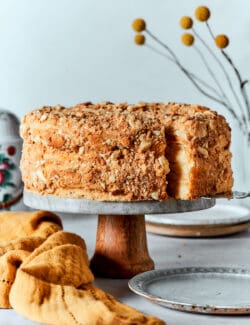
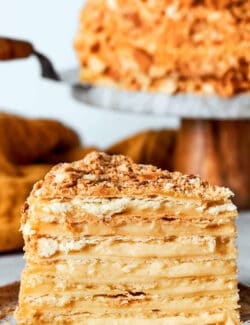
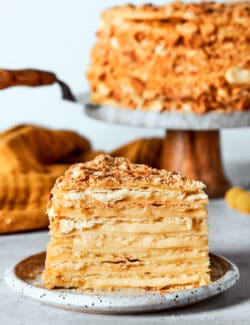
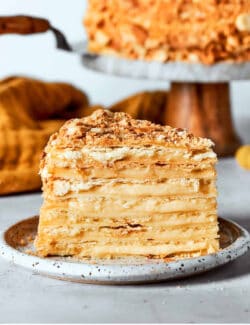
get new posts via email: